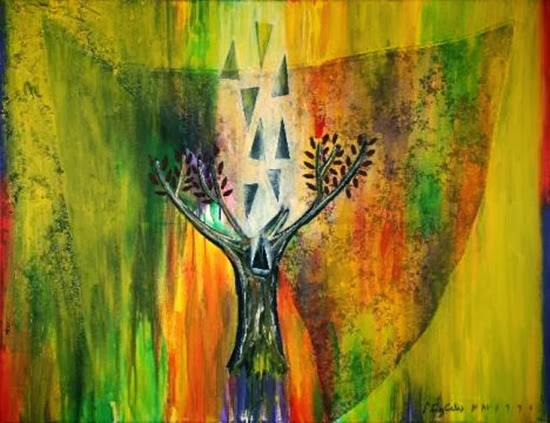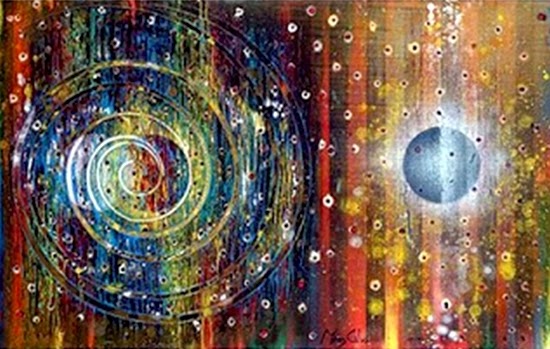Biography:
Celis Pérez (January 15, 1939 – August 2, 2008) was an Argentine artist usually referred to as Pérez Celis. He earned international recognition for his paintings, sculptures, murals and engravings.
Pérez was born in San Telmo on the South side of Buenos Aires, and grew up in Liniers, on the opposite end of town. Working as a newsboy during childhood, he learned the basics of drawing and painting via correspondence classes. He enrolled at the Belgrano School of Fine Arts in 1954, and first exhibited at age 17, at Galería La Fantasma. Following his entry into the professional arts world, he bagen using his name in a reversed form. Inspired by Hungarian artist Victor Vasarely during a 1957 restrospective of the latter's works at the National Fine Arts Museum, he married Sara Fernández, relocated to Uruguay, and joined figures such as Úrsula Von der Lippen and Carlos Páez Vilaró in the "Group of 8" – proponents of abstract art among the normally conservative local audiences.../
Celis Pérez (January 15, 1939 – August 2, 2008) was an Argentine artist usually referred to as Pérez Celis. He earned international recognition for his paintings, sculptures, murals and engravings.
Pérez was born in San Telmo on the South side of Buenos Aires, and grew up in Liniers, on the opposite end of town. Working as a newsboy during childhood, he learned the basics of drawing and painting via correspondence classes. He enrolled at the Belgrano School of Fine Arts in 1954, and first exhibited at age 17, at Galería La Fantasma. Following his entry into the professional arts world, he bagen using his name in a reversed form. Inspired by Hungarian artist Victor Vasarely during a 1957 restrospective of the latter's works at the National Fine Arts Museum, he married Sara Fernández, relocated to Uruguay, and joined figures such as Úrsula Von der Lippen and Carlos Páez Vilaró in the "Group of 8" – proponents of abstract art among the normally conservative local audiences.../
.../He returned to Buenos Aires in 1961, and opened a downtown atelier with the support of the Torcuato di Tella Institute, a major center for local contemporary artists. Pérez explored geometric art, and exhibited his first major work, Fuerza América, in 1962. Indigenous patterns and colors would reappear in many of his productions during the 1960s and 1970s, and distinguished him from most other local artists, among whom pop art and figurative art was more influential. Pérez was featured in more than 120 solo shows during his career, notably the Gallerie Bellechasse, and his art was purchased for many private collections and first-rate museums, including the Museum of Modern Art in New York. He received commissions from the Argentine government, which placed his work in the Ministro Pistarini International Airport, from other governments, and from prominent individuals and businesses.
Tragedy stuck Pérez Celis' life in 1975, when an automobile accident killed his wife, and resulted in months of physical therapy for his injuries. He remarried, to Margarita Laconich, in 1977, and lived in Caracas, New York, and Miami in subsequent years. He relocated to Buenos Aires in 1985, however, and hosted retrospectives of his work at the Centro Cultural Recoleta and the Argentine Senate, shortly afterwards. He lost his second wife, but continued to work, exhibiting in the Sanyo Gallery in Tokyo, and at numerous universities. Among his numerous recognitions in later years was the Alba Award at the 61st Salón Nacional de Artes Plásticas Argentino, and he was proclaimed a Distinguished Citizen of the City of Buenos Aires in 2001.../
Tragedy stuck Pérez Celis' life in 1975, when an automobile accident killed his wife, and resulted in months of physical therapy for his injuries. He remarried, to Margarita Laconich, in 1977, and lived in Caracas, New York, and Miami in subsequent years. He relocated to Buenos Aires in 1985, however, and hosted retrospectives of his work at the Centro Cultural Recoleta and the Argentine Senate, shortly afterwards. He lost his second wife, but continued to work, exhibiting in the Sanyo Gallery in Tokyo, and at numerous universities. Among his numerous recognitions in later years was the Alba Award at the 61st Salón Nacional de Artes Plásticas Argentino, and he was proclaimed a Distinguished Citizen of the City of Buenos Aires in 2001.../
.../He also created several literary illustrations, notably those for Jorge Luis Borges' Spanish-language translation of Walt Whitman's poem Leaves of Grass. A fan of the Club Atlético Boca Juniors football team, he created two murals in 1997 for the team's La Bombonera Stadium in Buenos Aires: "Idolos" (Idols) and "Mito y Destino" (Myth and Destiny), both Venetian mosaics and bronze on cement.



















1 comentario:
NICE! Lovely Textured Layers!
Publicar un comentario